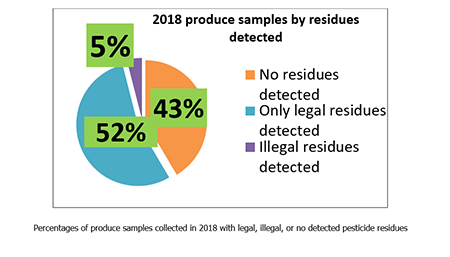Oct 28, 2019California reports low or no pesticide levels in most fruits, vegetables
Once again, tests showed that the vast majority of fresh produce collected by the California Department of Pesticide Regulation (DPR) met national pesticide residue standards. During its 2018 survey, DPR found 95 percent of all samples had no detectable pesticide residues or were actually below levels allowed by the U.S. Environmental Protection Agency (USEPA).
The findings are included in DPR’s just released 2018 Pesticide Residues in Fresh Produce report.
“We want to ensure that fresh fruits and vegetables, imported from other countries or grown right there in California are safe to consume,” said Val Dolcini, acting director of DPR.
The 2018 report is based on year-round collection of 3666 samples of produce, from dozens of different countries, including those labeled as “organic.” DPR scientists sampled produce from various grocery stores, farmers’ markets, food distribution centers, and other outlets throughout California. The produce is tested for more than 400 types of pesticides using state of the art equipment operated by the California Department of Food and Agriculture.
The U.S. Environmental Protection Agency sets levels for the maximum amounts of pesticide residue that can be present on fruits and vegetables, called a “tolerance.” It is a violation if any residue exceeds the tolerance for the specific fruit or vegetable, or if a pesticide is detected for which no tolerance has been established.
California specific results
More than a third of the country’s fruits and vegetables are grown in California according to the California Department of Food and Agriculture (CDFA). In 2018 DPR found:
- About 34 percent of all produce samples tested were labeled as California-grown,
- About 94 percent of the California-grown samples had no pesticide residues on them or were within the legal levels,
- About 6 percent of California samples had illegal pesticide residues, including Beet tops, Bok Choy and Kale, which was labelled as ‘organic’. None of the residues were at a level that would pose a health risk to consumers. However they had illegal traces of pesticides that were not approved for that commodity, or they had residues in excess of the established tolerance.
Other highlights from the 2018 report include:
- 43 percent of all produce samples had no detectable residues at all;
- 52 percent had residues detected within the legal level;
- 5 percent of all the samples had pesticide residues in excess of the established tolerance or had illegal traces of pesticides that were not approved for that commodity.
In 2018, DPR scientists determined that some of the produce grown outside California tested positive for illegal pesticide residues that could pose a potential health risk to consumers. These included Cactus Pear from Mexico, which contained chlorpyrifos and monocrotophos; Lychees from China, which contained chlorpyrifos; Chayote from Mexico, which contained monocrotophos; and Dragon Fruit from Florida, which contained acephate and methamidophos.
When illegal residues are found, DPR immediately works to remove the illegal produce to prevent it from reaching consumers and attempts to trace it to its source. DPR then verifies that the produce is either destroyed or returned to its source.
In 2018, DPR fined three produce companies with a history of recurring illegal pesticide residue violations a total of $30,000.
- See an archived 2014 video story of inspectors collecting samples and testing for pesticides.
- The 2018 pesticide residue monitoring report is posted at: http://www.cdpr.ca.gov/docs/enforce/residue/rsmonmnu.htm















